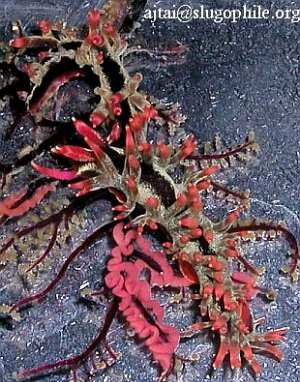

Hermosita hakunamatata
(Ortea, Caballer & Espinosa, 2003)
Order: NUDIBRANCHIA
Suborder: AEOLIDINA
Family: Glaucidae
DISTRIBUTION
It has a known distribution throughout the Mexican Pacific to Panama
PHOTO
Upper: Islas Murcielago, Costa Rica. 20ft. Photo: Peter Ajtai.. Lower: Isla Isabel, Nayarit, Mexico. Pacific Ocean. Depth: 32 feet. Length: 18 mm. 10 December 2003. Walls. Photo: Ali Hermosillo
Note added 8 February 2005: Previously known of the Forum as Flabellina sp. 3.
The animal is quite variable in colour. In dark specimens the body is black with opaque whitish bands down each side of the dorsum, consisting of opque whitish specks. The rhinophores and oral tentacles are translucent reddish pink, and the ceratal wall is covered in opaque whitish specks, except near the tip wher there is a band of reddish pink. The extreme tip of the cerata is white. In lighter coloured specimens, the black pigmentation is absent.
The pre cardiac and first two post cardiac groups of cerata on each side are arranged in single rowed arches, with up to 9 or 10 cerata in each arch. Behind that the cerata are arranged in sloping rows. The cerata have a distinct nipple-like tip, suggesting a cnidosac. The rhinophores bear numerous fine lamellae. The radular formula is 0.1.0 and the teeth, as illustrated in the original description, have a large pointed central cusp and approx 7 long pointed denticles on each side. It feeds on the hydroid Solanderia, and the dark colour form seems well camouflaged, the black central band on the dorsum, and whitish band on each side, matching the dark brown black trunk and whitish polyps of the Solanderia. It is reported to reach 18 mm in length. The egg ribbon is pinkish.
It was originally placed in the genus Phestilla [Family Tergipedidae], presumably on the shape of the radular teeth, but just from the information in the original description, this is most unlikely. For example, no tergipedid is known to have lamellate rhinophores, or cerata arranged in arches. One characteristic of the genus Phestilla is the replacement of the cnidosac with a swolen glandular tip to each ceras. From the photographs, this species almost certainly has cnidosacs. The long convoluted egg ribbon is also quite unlike that of any known species of Phestilla. While it is difficult to use the corallivorous feeding behaviour of all other species of Phestilla as a distinctive character, it should also be noted that this species is a hydroid feeder. See Alicia Hermisillo's message [#12811 ] in which she notes that 'its genus will be changed soon.... Sandra Millen and I have found the species to be a Hermosita rather than a Phestilla (no study of the reproductive system was done in the original description.'
-
Ortea, Jesus; Manuel Caballer and Jose Espinosa (2003) Nuevos Aeolidaceos (Mollusca:Gastropoda) de Costa Rica. Avicennia, 16: 129-142, figs. 1-4, 1 pl.
-
Hermosillo, Alicia (2004) Opisthobranch Mollusks of Parque Nacional de Coiba, Panamá. (Tropical Eastern Pacific). The Festivus, 36(9): 105-117.
Rudman, W.B., 2005 (February 9) Hermosita hakunamatata (Ortea, Caballer & Espinosa, 2003). [In] Sea Slug Forum. Australian Museum, Sydney. Available from http://www.seaslugforum.net/factsheet/hermhaku
Related messages
-
Flabellina sp. 3 = Phestilla hakunamatata
From: Ali Hermosillo, February 11, 2005 -
Flabellina from Costa Rica
From: Peter Ajtai, May 8, 2002
